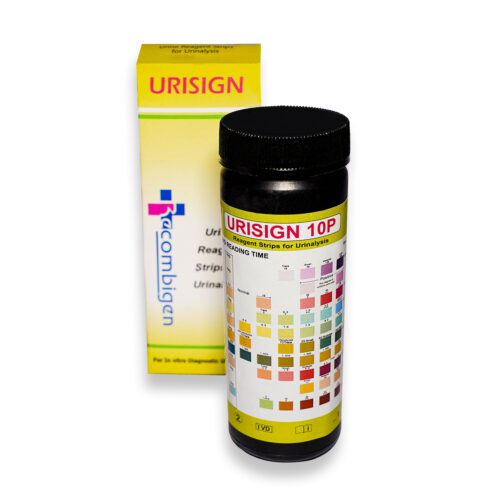Urisign – 10Perameter
₹360.00 – ₹655.00
| Number of Reactions(Preps)/Kit |
1 strip / Test
|
| Brand |
Recombigen- Urisign
|
| Material |
PVC
|
| Country of Origin |
Made in India
|
| Packaging Type |
Bottle
|
Professional Urine Test Strip for the rapid determination of Ketones (URS-K), Glucose, Protein and pH (URI-3) plus Leukocytes, Nitrites, Ketones, Bilirubin, Blood, Urobilinogen, and Specific Gravity (URI-10) levels in urine. The URS-UTI is a single use test specific for detection of urinary tract infections.
INSTRUCTIONS
1. Check the expiry date on the bottom of the container.
2. Use fresh urine not older than four hours. Mix well before testing, do not centrifuge.
3. Remove a test strip from the container and REPLACE THE CAP IMMEDIATELY 1 deposit casino uk.com
4. Briefly (no longer than one second) dip the entire test strip into the urine and remove immediately.
5. Blot one edge of the test strip on the absorbent tissue to remove excess urine.
6. Reading time for specific parameters are very much important for best results. Read Glucose & Bilirubin at 30 seconds after dipping; Ketone at 40 seconds; sp.Gravity at 45 seconds, Urobilinogen, Nitrite and blood at 60 seconds. The pH and protein may be read immediately or at anytime up to 1 minute after dipping. Read leukocytes after 60-120 seconds.
LEUKOCYTES
The chromogenic contained in the test is split by granulocytic esterase. This reaction release an indoxyl which reacts with a diazonium salt to from a pink-purple colour on the test patch. The intensity of the colour that forms is proportional to the number of leukocytes present in the urine sample. The results should be read between 60-120 seconds to allow for complete colour development. Low specific gravity, oxalic acid or traces of oxidising agents may cause false positives. Sensitivity decreases when urine contains > 160mmol/l (>2900mg/dl) glucose, high concentrations of albumin, specific gravity > 1.025, blood, tetracycline, cephalexin or gentamycin.
Sensitivity: 10 cells/µl urine
Active reagent: Chromogenic ester (0.45% w/w)
NITRITE
Gram negative bacteria in the urine reduce dietary nitrate to nitrite, forming the basis of the test. Any degree of uniform pink to red colour that appears on the test patch confirms the presence of nitrite, and indicates a significant bacteriuria. The colour intensity is not significant, and is not proportional to the number of bacteria present in the urine sample. Pink spots or pink edges should be interpreted as a negative result. Prolonged urinary retention in the bladder (at least 4-8 micturition and/or increased diuresis, with insufficient dietary nitrate to convert to nitrite, when the bacteria causing the urinary tract infection do not contain the enzyme reductase, and with urine of high specific gravity. fOr accurate results, antibiotics should be discontinued for at least 3 days before the test is performed.
Sensitivity : 11 µmol/dl nitrite
Active reagent : Aminonaphthalence (0.6% w/w)
UROBILINOGEN
The test uses a benzene diazonium salt which react with urobilinogen under acidic conditions to produce a range of pink-red colours. All colours indicating less than 17 µmol/l (1mg/dl) urobilinogen, should be interpreted as normal. A negative result at any time does not preclude the absence of urobilinogen. In addition, the test cannot be used to detect prophobilinogen. High concentrations of p-aminosalicylic acid and sulphonamides may obscure test patch colour. Nitrite, isonicotinic acid ( INH) and indole have little or no effect on the test.
Sensitivity : 3 µmol/l urobilinogen
Active reagent : 4 methoxybenzene diazonium fluorobrate (2.8% w/w)
PROTEIN (ALBUMIN)
The test incorporates a pH indicator which changes colour in the presence of protein. Any green colour that develops is due to the presence of protein in the urine. The test is highly sensitive for albumin, and less sensitive to hemoglobin, globulin, and mucoprotein. Normal urine of high specific gravity may cause higher than normal readings, as well highly buffered urine, alkaline urine (pH>9), and urine containing residues of chlorhexidine or quartenary ammonium compounds.
Sensitivity : 10 mg/dl albumin
Active reagent : Tetrabromophenol blue (1% w/w)
pH
The test is based on a double indicator principle which gives a broad range of colours covering the entire urinary pH range. With an increase in urinary pH, the indicators bromothymol blue and methyl red change from orange to green and blue.
Detection range : pH 5.0- 9.0
Active reagents : Bromothymol blue (6.0% w/w), methyl red (3.0% w/w)
BLOOD
An organic hydroperoxide the indicator in the presence of haemoglobin and myoglobin. The result is a change from light yellow through a range of green-blue colours. A uniform blue colour indicates the presence of myoglobin, haemoglobin and haemoloysed erythrocytes. Scattered or compacted blue sports indicate intact erythocytes. To enhance accuracy, separate colours scalesrs are provided for haemoglobin and for erythrocytes. Positive results with the test are often seen with urine from mensturating females. It has been reported that urine of high specific gravity reduces sensitivity, while moderate to high concentration of ascorbic acid may inhibit colour formation.
Sensitivity : 5-10 erythrocytes/µl urine
Active reagent : Peroxide (8% w/w), tolidine (7% w/w)
SPECIFIC GRAVITY
The test is a measurement of the ion concentration of the urine. In a cationic environment, protons released by a complexing agent will cause the indicator bromothymol blue to change colour from blue-green to yellow in urine of increasing ionic concentration. Moderate to high quantities of protein, ketoacidosic, and pH > 8 may elevate the result. The specific result is not affected by non-ionic urine components such as glucose.
Detection range : 1.000 – 1.030
Active reagents : Bromothymol blue (2.8% w/w)
ACETOACETIC ACID (KETONES)
When acetoacetic acid reacts with nitroprusside, a colour change develops covering the range from beige (negative) to marron (positive). The test does not react with acetone or β-hydroxy butyrate. Urine samples of low pH and high specifice gravity, and other substances containing sulfhydryl groups occasionally give reactions up to and including trace (+).
Sensitivity : 0.5 mmol/l acetoacetic acid
Active reagent : Nitropruside ( 7.5% w/w)
BILIRUBIN
The test is based on the reaction of bilirubin with a diazonium salt. Since bilirubin is absent in normal urine, any positive result including a trace indicates an underlying pathological condition and requires further investigation. The presence of bilirubin derived bile pigments may mask the bilirubin reaction. This phenomenon is characterised by any colour development on the test patch that does not correlate with the colours on the colour chart. Large concentrations of ascorbic acid may decrease sensitivity.
Sensitivity : 9 µmol/l bilirubin
Active reagent : Nitroaniline ( 0.8% w/w)
GLUCOSE
A double sequential enzymatic reaction, involving glucose oxidase and peroxidase in the presence of an indicator is responsible for the colour change. Ketones or other metabolic substances should not produce false positive as the test is highly specific for glucose. Sensitivity may decrease with urine of high specific gravity (>1.030) and with ascorbic acid concentrations of > 1.4 mml/l.
Sensitivity : 2.0 mmol/l glucose
Active reagents : Glucose oxidase (100 U/ml), peroxidase (100 U/ml)
| Weight | N/A |
|---|---|
| Dimensions | N/A |
| Strips | Strips 50, Strips 100 |
3 reviews for Urisign – 10Perameter
You must be logged in to post a review.

 Rapid Diagnostic Products
Rapid Diagnostic Products Serology Products
Serology Products Clinical Lab Accessories
Clinical Lab Accessories OTC Products
OTC Products Water Quality Test Kit
Water Quality Test Kit 















Eleanore –
I have been using the test kits extensively, and I must say, the results have been consistently accurate and reliable. The kit’s ability to detect ten parameters has proven to be incredibly useful, and it has significantly contributed to the efficiency of our testing processes.
The quality and performance of the UriSign test kit have exceeded my expectations, and I am genuinely impressed with the precision it offers. This has not only helped streamline our operations but also instilled confidence in our team and clients regarding the test results.
Terrell –
I highly recommend the Urisign 10-parameter urine test strips from Recombigen to anyone who values their health and wants a reliable, hassle-free method of monitoring their body’s vital signs. It’s a purchase that’s worth every penny!
Nora –
I recently purchased the Urisign 10-parameter urine test strips from Recombigen, and I must say I am extremely impressed with the quality and performance of these products.